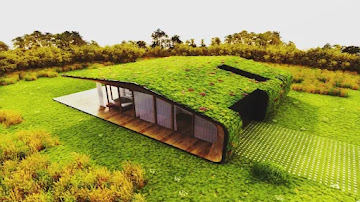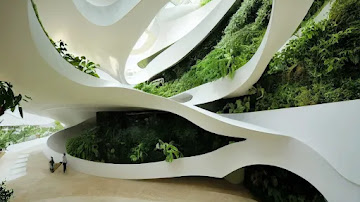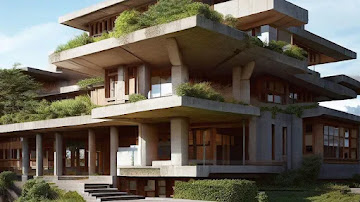Today I would like to talk about the impact of artificial intelligence on architecture in 2023. The world changed forever, artificial intelligence became accessible to the public for free through tools such as:
Chat gpt
completely changed the way we work. Its reputation grew from 0 to 1 million
users in just 5 days which is a record differential of any other platform in
the world, as a reference to Instagram took two months to reach one million users.
Learn more about: Architecture Definition
How does artificial intelligence influence architecture?
Lately,
there has been a lot of boom in architecture and artificial intelligence, in
recent years some people think it is about to transform the world we live in in
unimaginable ways and others are a little less optimistic. I prefer to keep an
open mind and try things for myself, I consider them tools just like Revit,
AutoCAD, Sketchup, etc. I think they are here to make work easier not to harm
us.
A few years
ago many people thought that the first thing that artificial intelligence would
replace was physical work and then it would be the simple clerical jobs and
then the specialists like programmers and coders and at the end the creative
jobs, but the interesting thing is that it happened the other way around.
With the
creation of programs that integrate artificial intelligence in architecture and
construction such as chat gpt, a transformative model that is trained on a
massive data set of text to understand and generate a human-like language.
It is
trained on millions of words, allowing it to understand and respond to a wide
variety of messages and questions. We at the architectural firm use the program
for basic tasks such as project descriptions, building codes, client mailings,
vendor messages, and much more. This
makes it easier for us to concentrate on more creative work.
This tool
if used responsibly can help develop the narrative that will capture the
attention of the audience. One can see that taking advantage of this tool can
have its benefits that will allow us to focus more on the creative work,
although the information provided is not yet attached to local laws and should
always be verified for accuracy.
What advantages and disadvantages does artificial intelligence offer us?
The tool
used in architecture allows a deeper analysis and understanding of professional
knowledge in architecture for practical design applications. Moving to
architectural image generation, there are programs such as mid-journey, dall-e,
and stable diffusion, as well as others, which are language models that can
generate images from text descriptions.
These tools
are trained using a data set of images, allowing you to understand the
relationship between text and images. This can be useful in a wide range of
applications such as creating images for architecture, marketing, advertising,
and other creative applications.
Programs
like mid-journey and dall-e can already make renders in seconds and several
images can be made at the same time. By putting all these images together they
could also make videos, in a short time we can already see virtual tours that
are created according to the commands you enter. At the moment the orders are
text-based but imagine integrating a voice function like Alexa, in combination
with virtual reality glasses you could be giving a tour in space and talk to
the artificial intelligence and recreate the different areas within the render
to your liking in real-time.
For
example, if we ask artificial intelligence to create a modern villa in the
style of Calatrava in a forest with many animals, depending on the result, we
can modify it in real-time as it would be adding more natural light to the room
and the ceiling in the form of an arch that puts a piano and a deer in the
middle.
Then the
artificial intelligence applied to architecture will modify it instantly at the
same time that you are giving the tour of the house, now imagine how these
visualizations are being created at the same time creating the bim, electrical
systems, and toilets, construction details and with all its specifications in
the most optimal way along with their most current market costs.
It's crazy,
but I think we are not far away from this, and going further, in the future,
you will replace virtual reality glasses with neural links. A brain interface
created by Elon Musk allows us to connect humans and machines. This will take
it a step further, where we might only be limited by our ability to speak or
write.
Neuralink
will be limited by our ability to think, you will be able to send and receive
information signals much faster and you can have the ability to visualize space
and solve any problem instantly. All this sounds like science fiction, but
remember that it is already very close to us.
So what do
you think is the role of the architect? Personally, the beauty of being an
architect is to design and conceive creativity if you program. Dall-e in the
present can already make a render quite developed to a client according to
their tastes and this technology is just in its infancy.
The role of
the architect after the integration of artificial intelligence in the future
may be in the field of construction, but we are not far from artificial
intelligence in architecture entering the physical world, a few days ago Boston
Dynamics published a video of the builder robot. As you can see this is what is
now and is growing rapidly, the robot in a few years will be identical to a
human.
In some
areas, it will function better than the human because it does not have to rest,
sleep or eat, at the time that these two merge physical and artificial
intelligence we will reach a point of superhuman intelligence. Imagine then
choosing the style of the house using a combination.
You could
easily send the order and it will automatically generate and send all the
details of the construction such as materials, construction schedule, logistics
times, and all the information involved in the construction of a house to the
last detail. You could also access the different areas of purchasing, technical
suppliers, and the team of robots that will automatically start working on the
construction in the most efficient way possible.
If we take
weeks or sometimes months for everything involved in the design process such as
pre-design, schematic design, design development, construction documents,
building permits, bidding, negotiations, and construction administration, AI in
architecture will be able to do all of this in a matter of minutes or maybe
seconds.
What is the future of artificial intelligence?
Do you
think clients would rather talk to artificial intelligence than to a human?
Imagine an AI architect who has played with millions of iterations of plans
from the world's best architects. This is what the best architects do in these
types of situations and the AI can process and learn in comparison to a human.
So the best
architect is going to have a minuscule percentage of experience of what an AI
architect is going to have. Maybe an architect can work on the best plan and
design 24 hours a day with any client you want, but if the AI architect is the
best version of the conventional architect, clients will naturally look to
partner with them instead of humans.
Clients
will also prefer to talk to him who has analyzed millions of questions and the
perfect answer to your question with the right tone of voice the right gesture
and the right time to say it. These are just a tiny part of the potential of
artificial intelligence and will have a gigantic impact on the lives of all of
us.
These tools
have major implications for how architects and designers can modify their
workflow and move into the future. AI won't take everyone's job just yet, but I
think for now we can harness the power of artificial intelligence in
architecture.
It is also
important to remember that artificial intelligence is only one aspect of a
successful move and that constant work, dedication, continuous learning, and
development play a bigger role in the success of an architect or designer.
Examples of Artificial Intelligence in Architecture
These
examples were made with the mid-journey platform, the command was
"futuristic house integrated with a hyper-realistic 8k tree" As a
result we got these 2 variants that I liked a lot. With this, I encourage you
to discover the potential of your ideas to realize your architectural concepts,
because as you write your vision is generated automatically and artificial
intelligence offers you different variables of it.










